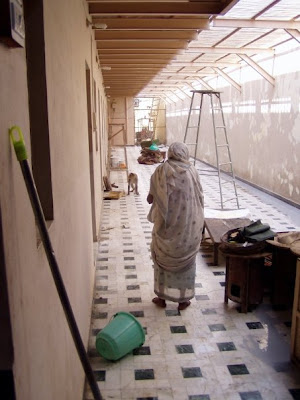I am here in Vrindavan for three reasons: (1) To help out Friends of Vrindavan, a local, environmental NGO; (2) to learn about Vrindavan’s religious and cultural life; and (3) to make a community art project.
I will be here for four months. I am bouncing ideas for a project around in my mind, but the most useful thing for me to do right now is to focus on steps 1 and 2. Hopefully the project will come directly out of what I learn.
Mr. Poddar, the head of the organization, has been a great host so far. Most mornings he arranges for me to observe some aspect of FoV’s activities, and then we’ll usually just talk about the organization – goals, difficulties, etc. (The FoV administrative staff is basically Mr. Poddar plus Monmon the accountant and Ravindra the field agent. It’s really small.)

Monmon and Mr. Poddar
This is what they are up to and how I might be able to contribute:
FoV is facilitating proper disposal of biomedical waste from the area’s 80 hospitals. Otherwise it would be dumped, untreated, into the river! I may be going around to some hospitals and getting doctors to answer questions and give suggestions on how to make that service run better.
One morning recently I went to observe a trash collector do his thing, house to house. The trash collectors are untouchables. In the photo you can see that people don’t hand him their trash directly – they avoid touching him by placing it in his bucket. FoV is also trying to help them improve their lives, higher pay and a few more opportunities than what they’d have otherwise.


FoV trash collection rickshaw. Different compartments for organic and inorganic waste.
I am going to help them design a brochure.
I might get trained on this paper press. Eventually they want poor widows and rag-pickers to be able to make recycled paper products from old rags and scraps, which they could then sell, either locally or to fair-trade stores abroad.

They also have a program where women weave colorful baskets out of plastic bags. I met a woman who does this, and hopefully there will be a training workshop sometime soon. I’d like to learn too.



I also got to see how they are making organic compost and fertilizer from the massive amounts of flower waste generated from religious activities. They make the fertilizer using the flowers plus cow urine and other natural ingredients. The compost is broken down by worms.


This is Mr. Poddar holding a bottle of organic fertilizer

compost and worms
Anyway, I am excited to be working with FoV because their focus, at least according to their mission statement on their website, links environmentalism with Hindu values. I am really interested in how culture affects how we act towards nature. Also, I mainly use found materials for my own sculpture. Some of the people FoV is working with – trash collectors, rag pickers, women who make crafts out of recycled materials – are very knowledgeable, resourceful, and skilled at finding uses for things others have discarded. I think I could learn a lot from them.




































